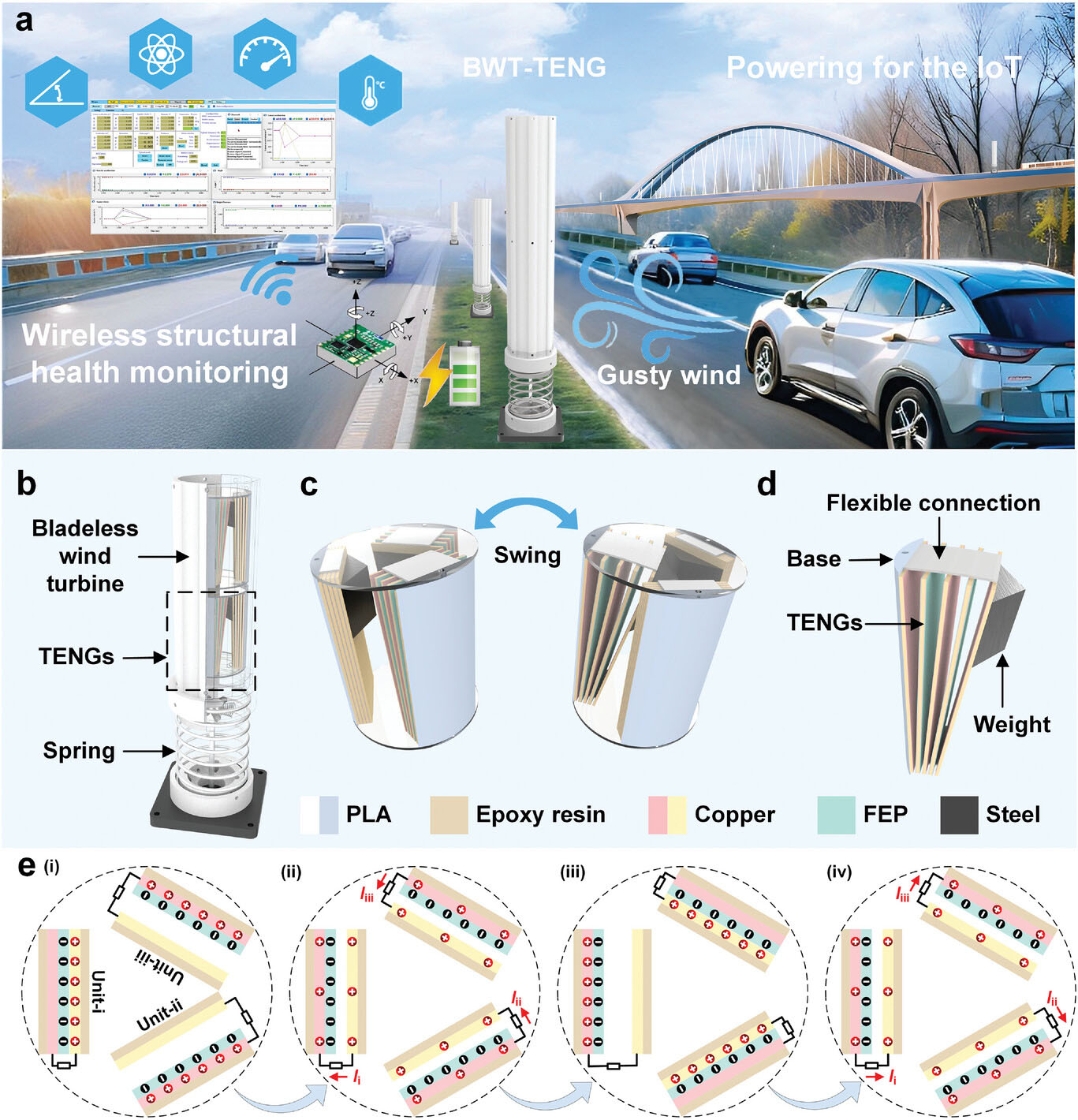| Jun 14, 2024 |
|
|
|
(Nanowerk Spotlight) In the pursuit of sustainable and renewable energy sources, wind energy has emerged as a key player. Traditional wind turbines, with their iconic spinning blades, have become a symbol of this green energy revolution. However, these turbines face limitations when it comes to harvesting energy from irregular, low-frequency wind gusts common in our environment. These gusts, fr instance generated by passing vehicles along roadsides, have proven challenging to effectively capture and utilize using conventional methods.
|
|
Over the years, researchers have sought innovative solutions to address this untapped potential. Electromagnetic generators, the mainstay of traditional wind turbines, struggle to efficiently convert the mechanical energy of these gusts into electricity due to their low frequency nature. Additionally, the irregular patterns and short durations of these wind bursts have hindered the development of reliable harvesting systems. As a result, a significant portion of available wind energy has remained unharnessed, leaving researchers searching for novel approaches to overcome these obstacles.
|
|
Advancements in adjacent technologies have opened up new possibilities. The emergence of triboelectric nanogenerators (TENGs) has introduced a groundbreaking approach to power generation. These devices, first introduced by Wang’s research group in 2012, capitalize on the triboelectric effect to convert mechanical energy into electricity.
|
|
TENGs have shown remarkable efficiency in harvesting energy from various sources, particularly those with high entropy and low frequencies. Their versatility, cost-effectiveness, and adaptability have positioned them as promising candidates for harnessing the elusive energy of random wind gusts.
|
|
Building upon these advancements, a research team led by Mingkang Zhu and colleagues has developed a pioneering solution: the bladeless wind turbine triboelectric nanogenerator (BWT-TENG). This innovative device combines the principles of bladeless wind turbines with the power of TENGs to effectively harvest energy from random wind gusts. The BWT-TENG represents a significant step forward in addressing the challenges that have long hindered progress in this field.
|
|
The team reported their findings in Advanced Energy Materials (“Bladeless Wind Turbine Triboelectric Nanogenerator for Effectively Harvesting Random Gust Energy”).
|
 |
| Application concept and principle of BWT-TENG. a) The concept of the BWT-TENG harvests roadside gusty wind energy to achieve distributed self-powering for structural health monitoring. b) Model structure of BWT-TENG. c) Working principle of the BWT-TENG. d) Detailed structure of the TENG unit. e) Charge transfer process of TENGs. (Image: Reproduced with permission by Wiley-VCH Verlag)
|
|
The BWT-TENG’s unique design revolves around a cylindrical bluff body, which serves as the wind energy harvesting component. Unlike traditional turbines with spinning blades, the BWT leverages the phenomenon of vortex-induced vibration, which enables it to harvest wind energy from any direction. As wind flows around the cylindrical structure, it generates pressure vortexes that cause the body to oscillate. By carefully designing the shape and aerodynamics of the bluff body, the researchers have optimized its performance under gust-driven conditions.
|
|
Experimental results have demonstrated its impressive performance, with a peak power density of 4.08 W/m3 achieved under a gust speed of 10 m/s.
|
|
At the heart of the BWT-TENG lies a multilayered TENG unit. Through meticulous parameter optimization, the team has developed a highly efficient power generation system. The TENG unit consists of alternating layers of triboelectric materials, such as fluorinated ethylene propylene (FEP) and copper, which generate electricity through the contact-separation mode. As the bluff body oscillates in response to wind gusts, the TENG layers come into contact and separate, inducing charge transfer and generating an alternating current.
|
|
The BWT-TENG’s innovative design enables it to harvest energy from wind gusts coming from any direction, making it highly adaptable to real-world environments. Remarkably, the device can operate effectively even at frequencies as low as 0.1 Hz, showcasing its ability to capture energy from incredibly slow and irregular wind patterns.
|
|
The potential applications of the BWT-TENG are vast and far-reaching. One particularly promising area is in the field of structural health monitoring. By harnessing the energy of wind gusts generated by passing vehicles, the BWT-TENG can power wireless sensors and monitoring systems for roads and bridges. This self-powered approach eliminates the need for external power sources or frequent battery replacements, enhancing the reliability and sustainability of structural health monitoring systems.
|
|
The researchers demonstrated this capability through a series of experiments. In a simulated rainfall environment, the BWT-TENG successfully powered a warning light, showcasing its resilience in adverse weather conditions. Furthermore, in a real-world scenario along a roadside, the device harvested gust energy from passing vehicles to power wireless gyroscopic sensors. These sensors transmitted crucial data, including 3D angles, angular velocities, and linear accelerations, enabling the detection of potential safety hazards such as tilting or fractures in road surfaces or bridges.
|
|
The development of the BWT-TENG represents a significant breakthrough in the field of wind energy harvesting. By effectively harnessing the untapped potential of random wind gusts, this innovative device opens up new avenues for sustainable and distributed power generation. Its ability to enable self-powered structural health monitoring systems showcases just one of the many potential applications that could benefit from this technology.
|
|
As research in this field continues to advance, the BWT-TENG serves as a testament to the ingenuity and dedication of scientists in their pursuit of sustainable energy solutions. The combination of bladeless wind turbine design with the power of triboelectric nanogenerators has unlocked new possibilities for harnessing the abundant but elusive energy of wind gusts. With further refinements and scale-up, this technology holds the promise of transforming the way we approach wind energy harvesting and its integration into various aspects of our lives.
|
|
The BWT-TENG’s ability to harvest energy from low-frequency and irregular wind patterns, coupled with its omnidirectional capabilities, positions it as a versatile and adaptable solution for a wide range of applications. From powering remote sensors in environmental monitoring systems to enabling self-sustaining smart city infrastructure, the potential impact of this technology is immense.
|
|
The research conducted by Mingkang Zhu and colleagues serves as an inspiring example of the incredible advancements being made in the field of renewable energy. Their work on the BWT-TENG not only pushes the boundaries of what is possible in wind energy harvesting but also highlights the importance of interdisciplinary collaboration and innovative thinking in tackling complex challenges.
|
|
As this technology continues to evolve and mature, it is likely that we will see an increasing number of applications and implementations across various sectors. From powering remote sensing networks to enabling self-sustaining smart infrastructure, the BWT-TENG has the potential to revolutionize the way we approach energy harvesting and utilization.
|
|

By
Michael
Berger
– Michael is author of three books by the Royal Society of Chemistry:
Nano-Society: Pushing the Boundaries of Technology,
Nanotechnology: The Future is Tiny, and
Nanoengineering: The Skills and Tools Making Technology Invisible
Copyright ©
Nanowerk LLC
|
|
|
- SEO Powered Content & PR Distribution. Get Amplified Today.
- PlatoData.Network Vertical Generative Ai. Empower Yourself. Access Here.
- PlatoAiStream. Web3 Intelligence. Knowledge Amplified. Access Here.
- PlatoESG. Carbon, CleanTech, Energy, Environment, Solar, Waste Management. Access Here.
- PlatoHealth. Biotech and Clinical Trials Intelligence. Access Here.
- Source: https://www.nanowerk.com/spotlight/spotid=65391.php





